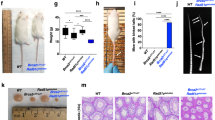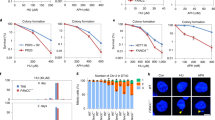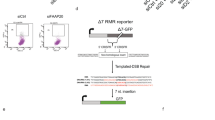Abstract
Fanconi anemia (FA) is a genome instability syndrome that is characterized by progressive bone marrow failure and a high risk of cancer. FA patients are particularly susceptible to leukemia as well as squamous cell carcinomas (SCCs) of the head and neck, anogenital region and skin. Thirteen complementation groups and the corresponding FA genes have been identified, and their protein products assemble into nuclear core complexes during DNA-damage responses. Much progress has been made in our understanding of post-translational FA protein modifications and physical interactions. By contrast, little is known about the control of protein availability at the level of transcription. We report here that multiple FA proteins were downregulated during the proliferative arrest of primary human keratinocytes and HeLa cells, and that the observed regulation was at a transcriptional level. Proliferative stimuli such as expression of HPV16 E7 as well as E2F1 overexpression in primary cells resulted in coordinate FA upregulation. To define the underlying mechanism, we examined the endogenous FANCD2 promoter, and detected regulated binding of members of the E2F/Rb family in chromatin immunoprecipitation assays. Finally, a 1 kb promoter fragment was sufficient to confer E2F/Rb regulation in reporter assays. Taken together, our data demonstrate FA gene co-regulation in synchrony with the cell cycle and suggest that deregulated expression of individual FA genes—in addition to FA gene mutation—may promote FA-related human cancer.
This is a preview of subscription content, access via your institution
Access options
Subscribe to this journal
Receive 50 print issues and online access
$259.00 per year
only $5.18 per issue
Buy this article
- Purchase on Springer Link
- Instant access to full article PDF
Prices may be subject to local taxes which are calculated during checkout




Similar content being viewed by others
References
Alter BP . (2003). Cancer in Fanconi anemia, 1927–2001. Cancer 97: 425–440.
Angus SP, Fribourg AF, Markey MP, Williams SL, Horn HF, DeGregori J et al. (2002). Active RB elicits late G1/S inhibition. Exp Cell Res 276: 201–213.
Angus SP, Mayhew CN, Solomon DA, Braden WA, Markey MP, Okuno Y et al. (2004). RB reversibly inhibits DNA replication via two temporally distinct mechanisms. Mol Cell Biol 24: 5404–5420.
Bagby GC, Alter BP . (2006). Fanconi anemia. Semin Hematol 43: 147–156.
Bindra RS, Crosby ME, Glazer PM . (2007). Regulation of DNA repair in hypoxic cancer cells. Cancer Metastasis Rev 26: 249–260.
Bindra RS, Glazer PM . (2006). Basal repression of BRCA1 by multiple E2Fs and pocket proteins at adjacent E2F sites. Cancer Biol Ther 5: 1400–1407.
Bridge AJ, Pebernard S, Ducraux A, Nicoulaz AL, Iggo R . (2003). Induction of an interferon response by RNAi vectors in mammalian cells. Nat Genet 34: 263–264.
Chang YE, Pena L, Sen GC, Park JK, Laimins LA . (2002). Long-term effect of interferon on keratinocytes that maintain human papillomavirus type 31. J Virol 76: 8864–8874.
Chen CC, Taniguchi T, D'Andrea A . (2007). The Fanconi anemia (FA) pathway confers glioma resistance to DNA alkylating agents. J Mol Med 85: 497–509.
Chen Q, Van der Sluis PC, Boulware D, Hazlehurst LA, Dalton WS . (2005). The FA/BRCA pathway is involved in melphalan-induced DNA interstrand cross-link repair and accounts for melphalan resistance in multiple myeloma cells. Blood 106: 698–705.
Classon M, Dyson N . (2001). p107 and p130: versatile proteins with interesting pockets. Exp Cell Res 264: 135–147.
Cobrinik D . (2005). Pocket proteins and cell cycle control. Oncogene 24: 2796–2809.
Dhillon VS, Shahid M, Husain SA . (2004). CpG methylation of the FHIT, FANCF, cyclin-D2, BRCA2 and RUNX3 genes in granulosa cell tumors (GCTs) of ovarian origin. Mol Cancer 3: 33.
Dimri GP, Lee X, Basile G, Acosta M, Scott G, Roskelley C et al. (1995). A biomarker that identifies senescent human cells in culture and in aging skin in vivo. Proc Natl Acad Sci USA 92: 9363–9367.
Dotto GP . (1999). Signal transduction pathways controlling the switch between keratinocyte growth and differentiation. Crit Rev Oral Biol Med 10: 442–457.
Dressman HK, Berchuck A, Chan G, Zhai J, Bild A, Sayer R et al. (2007). An integrated genomic-based approach to individualized treatment of patients with advanced-stage ovarian cancer. J Clin Oncol 25: 517–525.
Duensing S, Munger K . (2004). Mechanisms of genomic instability in human cancer: insights from studies with human papillomavirus oncoproteins. Int J Cancer 109: 157–162.
Fehrmann F, Laimins LA . (2005). Human papillomavirus type 31 life cycle: methods for study using tissue culture models. Methods Mol Biol 292: 317–330.
Garcia-Higuera I, Taniguchi T, Ganesan S, Meyn MS, Timmers C, Hejna J et al. (2001). Interaction of the Fanconi anemia proteins and BRCA1 in a common pathway. Mol Cell 7: 249–262.
Goodwin EC, DiMaio D . (2000). Repression of human papillomavirus oncogenes in HeLa cervical carcinoma cells causes the orderly reactivation of dormant tumor suppressor pathways. Proc Natl Acad Sci USA 97: 12513–12518.
Goodwin EC, Yang E, Lee C-J, Lee H-W, DiMaio D, Hwang E-S . (2000). Rapid induction of senescence in human cervical carcinoma cells. Proc Natl Acad Sci USA 97: 10978–10983.
Gunawardena RW, Siddiqui H, Solomon DA, Mayhew CN, Held J, Angus SP et al. (2004). Hierarchical requirement of SWI/SNF in retinoblastoma tumor suppressor-mediated repression of Plk1. J Biol Chem 279: 29278–29285.
Gurtan AM, D'Andrea AD . (2006). Dedicated to the core: understanding the Fanconi anemia complex. DNA Repair (Amst) 5: 1119–1125.
Joenje H, Patel KJ . (2001). The emerging genetic and molecular basis of Fanconi anaemia. Nat Rev Genet 2: 446–457.
Johung K, Goodwin EC, DiMaio D . (2007). Human papillomavirus E7 repression in cervical carcinoma cells initiates a transcriptional cascade driven by the retinoblastoma family, resulting in senescence. J Virol 81: 2102–2116.
Kennedy RD, Chen CC, Stuckert P, Archila EM, De la Vega MA, Moreau LA et al. (2007). Fanconi anemia pathway-deficient tumor cells are hypersensitive to inhibition of ataxia telangiectasia mutated. J Clin Invest 117: 1440–1449.
Kennedy RD, D'Andrea AD . (2005). The Fanconi Anemia/BRCA pathway: new faces in the crowd. Genes Dev 19: 2925–2940.
Kiyono T, Hiraiwa A, Fujita M, Hayashi Y, Akiyama T, Ishibashi M . (1997). Binding of high-risk human papillomavirus E6 oncoproteins to the human homologue of the Drosophila discs large tumor suppressor protein. Proc Natl Acad Sci USA 94: 11612–11616.
Kobayashi T, Hashimoto K, Yoshikawa K . (1994). Dephosphorylation of the retinoblastoma gene product induced by differentiation and its relevancy to growth inhibition in normal human keratinocytes. J Dermatol Sci 8: 171–177.
Kutler DI, Singh B, Satagopan J, Batish SD, Berwick M, Giampietro PF et al. (2003). A 20-year perspective on the International Fanconi Anemia Registry (IFAR). Blood 101: 1249–1256.
Laemmli UK . (1970). Cleavage of structural proteins during the assembly of the head of bacteriophage T4. Nature 227: 680–685.
Leveille F, Ferrer M, Medhurst AL, Laghmani el H, Rooimans MA, Bier P et al. (2006). The nuclear accumulation of the Fanconi anemia protein FANCE depends on FANCC. DNA Repair (Amst) 5: 556–565.
Marsit CJ, Liu M, Nelson HH, Posner M, Suzuki M, Kelsey KT . (2004). Inactivation of the Fanconi anemia/BRCA pathway in lung and oral cancers: implications for treatment and survival. Oncogene 23: 1000–1004.
Mathew CG . (2006). Fanconi anaemia genes and susceptibility to cancer. Oncogene 25: 5875–5884.
Meijer GA . (2007). The 13th Fanconi anemia gene identified: FANCI—importance of the ‘Fanconi anemia pathway’ for cellular oncology. Cell Oncol 29: 181–182.
Mulloy JC, Jankovic V, Wunderlich M, Delwel R, Cammenga J, Krejci O et al. (2005). AML1-ETO fusion protein up-regulates TRKA mRNA expression in human CD34+ cells, allowing nerve growth factor-induced expansion. Proc Natl Acad Sci USA 102: 4016–4021.
Nakahara T, Peh WL, Doorbar J, Lee D, Lambert PF . (2005). Human papillomavirus type 16 E1circumflexE4 contributes to multiple facets of the papillomavirus life cycle. J Virol 79: 13150–13165.
Narayan G, Arias-Pulido H, Nandula SV, Basso K, Sugirtharaj DD, Vargas H et al. (2004). Promoter hypermethylation of FANCF: disruption of Fanconi Anemia-BRCA pathway in cervical cancer. Cancer Res 64: 2994–2997.
Niedzwiedz W, Mosedale G, Johnson M, Ong CY, Pace P, Patel KJ . (2004). The Fanconi anaemia gene FANCC promotes homologous recombination and error-prone DNA repair. Mol Cell 15: 607–620.
Oberley MJ, Inman DR, Farnham PJ . (2003). E2F6 negatively regulates BRCA1 in human cancer cells without methylation of histone H3 on lysine 9. J Biol Chem 278: 42466–42476.
Pace P, Johnson M, Tan WM, Mosedale G, Sng C, Hoatlin M et al. (2002). FANCE: the link between Fanconi anaemia complex assembly and activity. EMBO J 21: 3414–3423.
Pagano G, Youssoufian H . (2003). Fanconi anaemia proteins: major roles in cell protection against oxidative damage. Bioessays 25: 589–595.
Patel KJ, Joenje H . (2007). Fanconi anemia and DNA replication repair. DNA Repair (Amst) 6: 885–890.
Pejovic T, Yates JE, Liu HY, Hays LE, Akkari Y, Torimaru Y et al. (2006). Cytogenetic instability in ovarian epithelial cells from women at risk of ovarian cancer. Cancer Res 66: 9017–9025.
Reid S, Schindler D, Hanenberg H, Barker K, Hanks S, Kalb R et al. (2007). Biallelic mutations in PALB2 cause Fanconi anemia subtype FA-N and predispose to childhood cancer. Nat Genet 39: 162–164.
Reimer D, Sadr S, Wiedemair A, Stadlmann S, Concin N, Hofstetter G et al. (2007). Clinical relevance of E2F family members in ovarian cancer--an evaluation in a training set of 77 patients. Clin Cancer Res 13: 144–151.
Russell PA, Pharoah PD, De Foy K, Ramus SJ, Symmonds I, Wilson A et al. (2000). Frequent loss of BRCA1 mRNA and protein expression in sporadic ovarian cancers. Int J Cancer 87: 317–321.
Siddiqui H, Solomon DA, Gunawardena RW, Wang Y, Knudsen ES . (2003). Histone deacetylation of RB-responsive promoters: requisite for specific gene repression but dispensable for cell cycle inhibition. Mol Cell Biol 23: 7719–7731.
Spardy N, Duensing A, Charles D, Haines N, Nakahara T, Lambert PF et al. (2007). The human papillomavirus type 16 E7 oncoprotein activates the Fanconi Anemia (FA) pathway and causes accelerated chromosomal instability in FA cells. J Virol 81: 13265–13270.
Taniguchi T, Garcia-Higuera I, Andreassen PR, Gregory RC, Grompe M, D'Andrea AD . (2002). S-phase-specific interaction of the Fanconi anemia protein, FANCD2, with BRCA1 and RAD51. Blood 100: 2414–2420.
Tategu M, Arauchi T, Tanaka R, Nakagawa H, Yoshida K . (2007). Systems biology-based identification of crosstalk between E2F transcription factors and the Fanconi anemia pathway. Gene Regulat Syst Biol 1: 1–8.
Thompson ME, Jensen RA, Obermiller PS, Page DL, Holt JT . (1995). Decreased expression of BRCA1 accelerates growth and is often present during sporadic breast cancer progression. Nat Genet 9: 444–450.
van der Heijden MS, Brody JR, Dezentje DA, Gallmeier E, Cunningham SC, Swartz MJ et al. (2005). In vivo therapeutic responses contingent on Fanconi anemia/BRCA2 status of the tumor. Clin Cancer Res 11: 7508–7515.
Wang W . (2007). Emergence of a DNA-damage response network consisting of Fanconi anaemia and BRCA proteins. Nat Rev Genet 8: 735–748.
Wells SI, Aronow BJ, Wise TM, Williams SS, Couget JA, Howley PM . (2003). Transcriptome signature of irreversible senescence in human papillomavirus-positive cervical cancer cells. Proc Natl Acad Sci USA 100: 7093–7098.
Wells SI, Francis DA, Karpova AY, Dowhanick JJ, Benson JD, Howley PM . (2000). Papillomavirus E2 induces senescence in HPV-positive cells via pRB- and p21CIP-dependent pathways. EMBO J 19: 5762–5771.
Wise-Draper TM, Allen HV, Thobe MN, Jones EE, Habash KB, Munger K et al. (2005). The human DEK proto-oncogene is a senescence inhibitor and an upregulated target of high-risk human papillomavirus E7. J Virol 79: 14309–14317.
Wreesmann VB, Estilo C, Eisele DW, Singh B, Wang SJ . (2007). Downregulation of fanconi anemia genes in sporadic head and neck squamous cell carcinoma. ORL J Otorhinolaryngol Relat Spec 69: 218–225.
Xia B, Dorsman JC, Ameziane N, De Vries Y, Rooimans MA, Sheng Q et al. (2007). Fanconi anemia is associated with a defect in the BRCA2 partner PALB2. Nat Genet 39: 159–161.
Acknowledgements
We thank Paul Andreassen, Ruhikanta Meetei, Qishen Pang, James Mulloy, Harmut Geiger, Yi Zheng and David Williams for helpful discussions and critical comments on the paper. We thank Jennifer Higginbotham for excellent technical assistance. We are grateful to Paul Lambert for providing NIKs and J23T3 cells and expert advice, as well as to James Lessard for the monoclonal actin antibody. We are grateful to Denise Galloway for the HPV16 E6 and E7 retroviral vectors. We thank Maureen Hoatlin for FANCA antibodies, and the Fanconi Anemia Research Fund for FANCC and FANCG antibodies. Vector supernatant was provided by the CCHMC Viral Vector Core and Translational Trials Development and Support Lab. This research was supported by Public Health Service grant CA102357, a grant from the Translational Research Initiative at CCHMC and a grant from the Fanconi Anemia Research Fund to SIW, and CA104213 to ESK.
Author information
Authors and Affiliations
Corresponding author
Rights and permissions
About this article
Cite this article
Hoskins, E., Gunawardena, R., Habash, K. et al. Coordinate regulation of Fanconi anemia gene expression occurs through the Rb/E2F pathway. Oncogene 27, 4798–4808 (2008). https://doi.org/10.1038/onc.2008.121
Received:
Revised:
Accepted:
Published:
Issue Date:
DOI: https://doi.org/10.1038/onc.2008.121
Keywords
This article is cited by
-
Inhibition of USP28 overcomes Cisplatin-resistance of squamous tumors by suppression of the Fanconi anemia pathway
Cell Death & Differentiation (2022)
-
Directed differentiation of human pluripotent stem cells into epidermal stem and progenitor cells
Molecular Biology Reports (2021)
-
Fanconi anemia pathway as a prospective target for cancer intervention
Cell & Bioscience (2020)
-
Chemotherapy impacts on the cellular response to CDK4/6 inhibition: distinct mechanisms of interaction and efficacy in models of pancreatic cancer
Oncogene (2020)
-
Genome-wide analysis of canine oral malignant melanoma metastasis-associated gene expression
Scientific Reports (2019)



